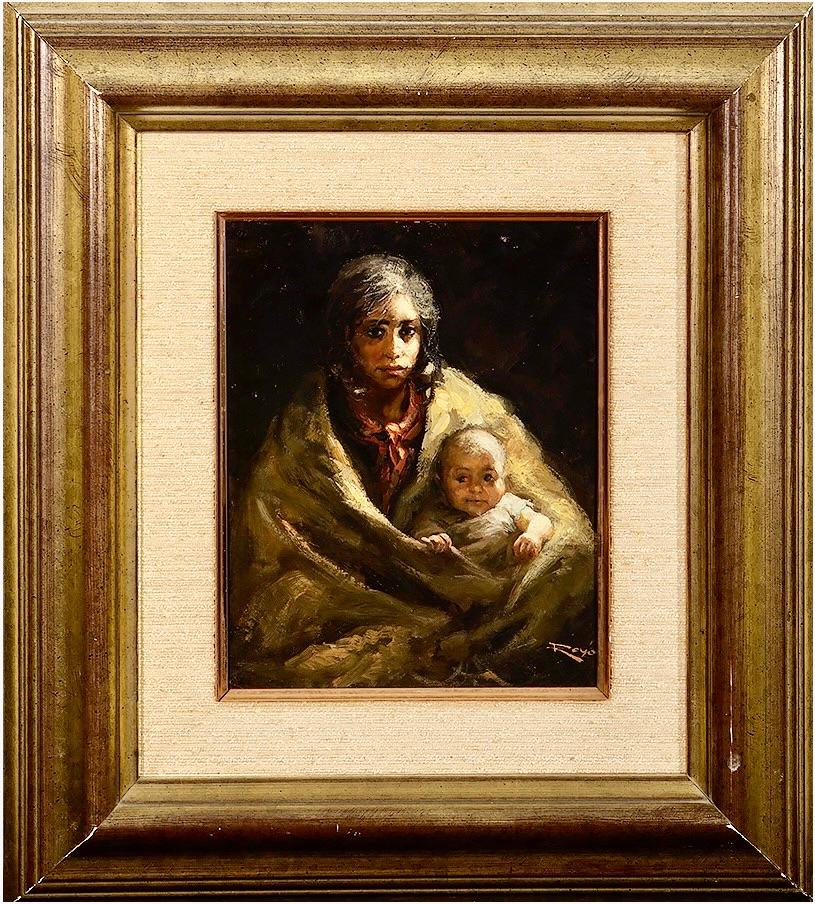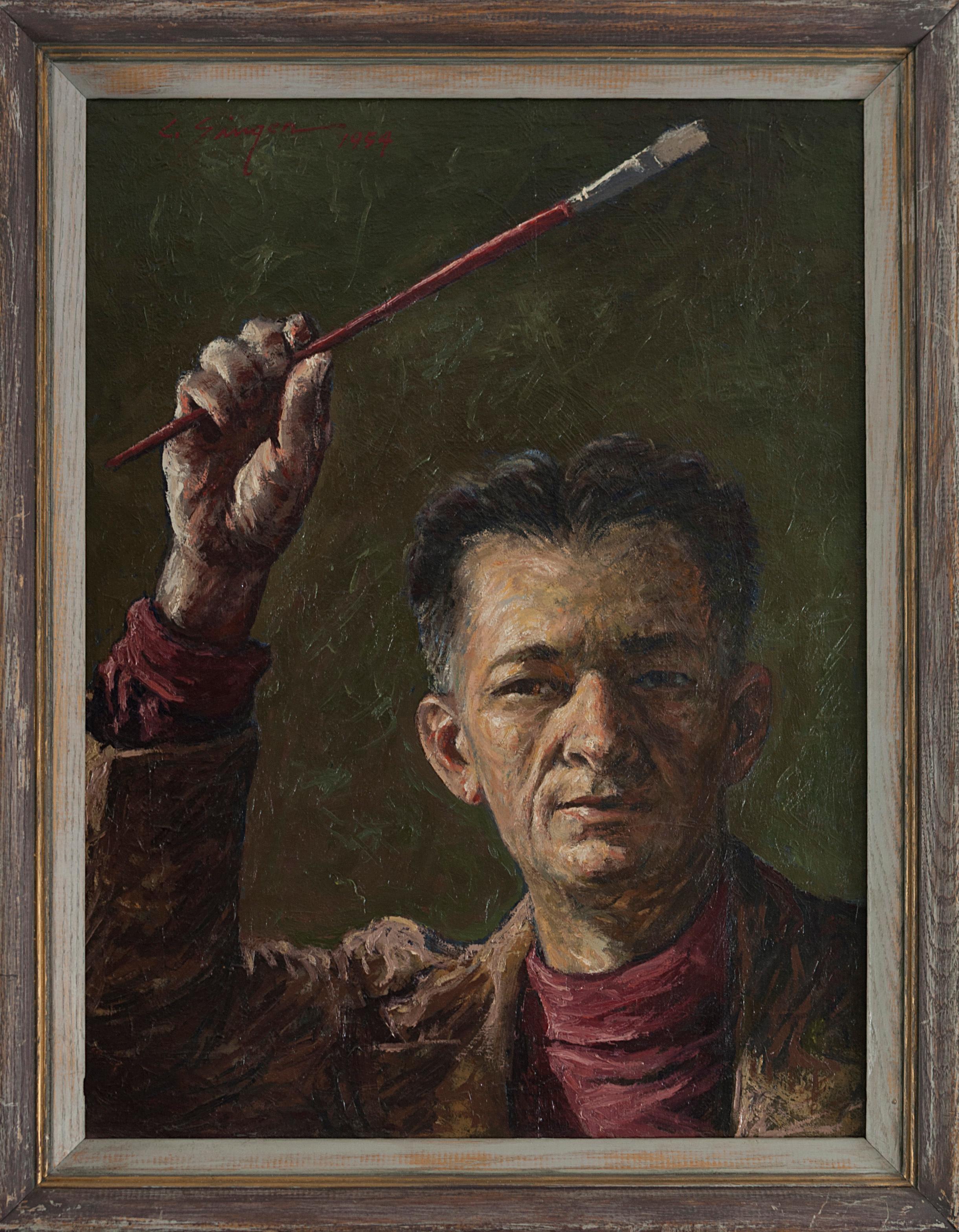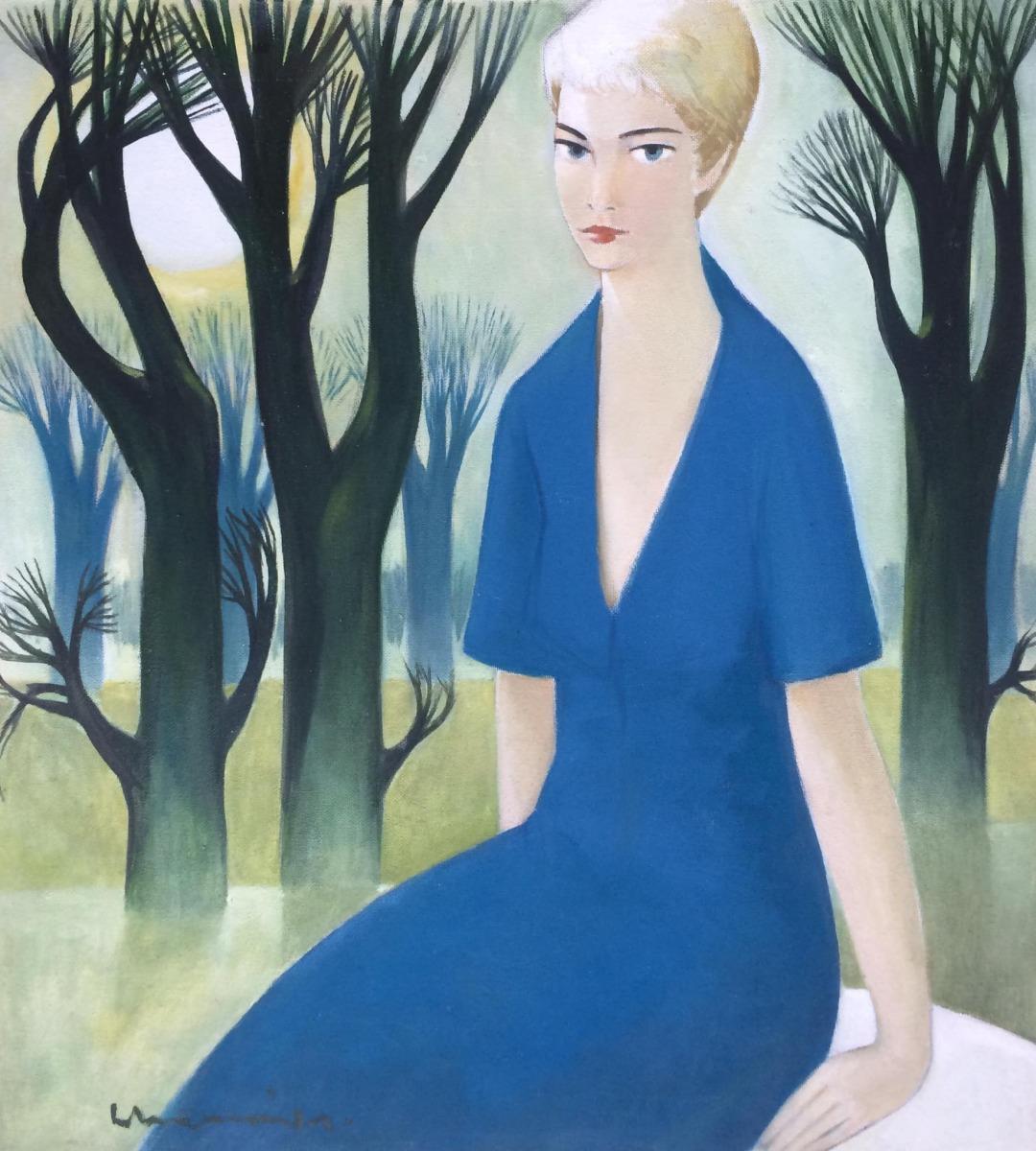Items Similar to Clown, Early 20th Century Playful Oil Painting on Board
Want more images or videos?
Request additional images or videos from the seller
1 of 6
Maurice KishClown, Early 20th Century Playful Oil Painting on Board
About the Item
This portrait of a clown by Maurice Kish is part from a series of carnival figures, circus clowns and carousel horses and riders that he did in the 30s and 40s. The artist uses a vibrant color palette and controlled brushstrokes to depict the subject in a realistic way.
The imagery of Maurice Kish (1895-1987), whether factories or carousels, reliably subverts expectations. His vision hovers just around the unraveling edge of things, where what is solid and clear becomes ambiguous. He is fascinated, often delighted, by the falling apart. This unexpected, fresh perspective results in oddly affecting pictures of a now long-gone New York.
Born Moishe in a town called Dvinsk, Russia (what is now Daugavpils, Latvia), Kish came with his family to New York when he was in his teens. The family settled in Brownsville, and for the rest of Kish’s life Brooklyn remained his home, though he moved from one neighborhood to another. He was close to his parents, who recognized his talent and supported his desire to become an artist.
Kish attended the National Academy of Design as well as Cooper Union. His fellow students included many other immigrants and children of immigrants who were particularly receptive to the Modernism coming from Europe. As his career progressed, Kish himself applied different strains of Modernism to different purposes. For him, the story was held above all else.
For years, Kish used the skills he acquired in art school to earn his living at a Manhattan glass factory where he painted floral designs on vases. During the Depression, Kish became a WPA painter in the Federal Art Project (FAP). FAP artists were given a mandate to create works that celebrated labor. The artists tended to be socially progressive, as Kish certainly was. Kish's work from this period, with its dark colors and rolling clouds, reveals the influence of Social Realists like Thomas Hart Benton. Apparent, too, is Kish's interest in the urban monumentality of Charles Sheeler. Kish's structures, however, lack Sheeler's almost dehumanized precision. Rather than the soulless, sleek machines of a typical modern urban dystopia, Kish's factories are shaggy old beasts as worn out as the laborers who troop through their doors. In End of Day's Toil, now at the Smithsonian, the viewer feels some affection for that rambly grandfather of a building all the tired small workers are leaving behind.
Much of Kish's work, for the FAP and elsewhere, undermines received truths in a similar way. Some early works with themes from Yiddish culture are overtly humorous: a painting of a big jolly wedding guest, looking invitingly over her shoulder; a big fiddler on a small roof. Later, the humor becomes more ironic and reflective. In another work, the rather imposing organ grinder of the late 1930s looms above a child, yet his intermediary the cockatoo is bright and appealing, and offers the girl a fortune with his beak. This could read as an allegory for capitalism as easily as a straightforward colorful street scene. A small painting of a snowy day in Washington Square gives a bird's eye view of people bent against the wind walking alone or in pairs. The huge triumphal arch at the middle of it has no connection to their movements or their lives. Kish makes its size and centrality a quiet joke about the futility of grandiose gestures. Like the buildings in his FAP works, the arch has a personality. It is a landmark that looks a bit lost.
A favorite location for Kish was Coney Island. For the laborers of the city, this was a place of great freedom and possibility. There were no bosses! Anyone could go to ride the rides and swim in the sea. For Kish, Coney Island, and especially Luna Park, became a place richly symbolic of workers’ rights. For the dreamlike paintings he set there, Kish looked past the Social Realists to the Expressionists. His colors are brilliant and his lines are wild. These images, joyfully unrestrained, give full voice to an anarchic vision merely hinted at in other works. If the structures of the earlier pictures came further out of the background than expected, these Coney Island structures completely take over the scene.
Kish made several variations on the theme of the carousel as a site of revolution. In the moonlight, the horses have broken from their poles and spin away from the calm center. The workers have come to manic life, have released themselves from the yoke of labor and have abandoned their master, the merry-go-round. They escape to different corners of the pleasure park, dance together and ride the ferris wheel. One horse pretends to be a ticket seller. It is another allegory, one that depicts a worker's holiday paradise in carnival fashion.
A painter who embraced ambiguity, Kish was himself a man who occupied many worlds simultaneously. Even during the period when he had shows at prestigious galleries and belonged to several artists' groups, he identified most strongly as an outsider, a Yiddischer. He wrote poetry in Yiddish throughout his life. In 1968, he published a volume of fifty years of these poems, Di Velt ist Mayn Lid (The World is My Song) in Yiddish, with no English translation, for his peers. Kish also translated English-language poetry into Yiddish and acted as a guide to help other Yiddish writers. Long after the art organizations ceased to provide meaning and fulfillment, Kish was a devoted member of the Yiddish Culture Association.
In addition to painting and poetry, Kish was a dancer who taught during the summers at various Jewish resorts in the Catskills. Small but lithe, he also spent some years as an amateur boxer. Well into his eighties, Kish was proud of the quality of his handball game.
By the 1940s, Kish’s career was going well, but his descriptive style of working began to fall out of fashion, supplanted by a more formal Abstraction. Kish was never able to support himself solely through his art, yet in the midst of all of his other activities, Kish continued to create his distinctive images of an immigrant's New York. He departed far from the mainstream, and in later years, seldom showed his work, preferring to keep it for himself (although he sometimes traded paintings for rent).
Of making art, Kish said, "It is a sacred mission to enrich, to elevate and to make our lives more complete." His works, though frequently playful, encourage a second look at ordinary things. His irreverence elevates by revealing flaws where his audience, all workers and outsiders of a kind, can get a purchase. Kish's art fondly celebrates the beauty of the irregular.
- Creator:Maurice Kish (1895-1987, American)
- Dimensions:Height: 23.25 in (59.06 cm)Width: 20.25 in (51.44 cm)
- Medium:
- Movement & Style:
- Period:
- Condition:minor chips. please see photos, measurements include frame.
- Gallery Location:Surfside, FL
- Reference Number:1stDibs: LU38211934402
About the Seller
4.9
Platinum Seller
These expertly vetted sellers are 1stDibs' most experienced sellers and are rated highest by our customers.
Established in 1995
1stDibs seller since 2014
1,543 sales on 1stDibs
Typical response time: 1 hour
- ShippingRetrieving quote...Ships From: Surfside, FL
- Return PolicyA return for this item may be initiated within 3 days of delivery.
More From This SellerView All
- Clown, Modernist Oil Painting on Board WPA ArtistBy Maurice KishLocated in Surfside, FLThis portrait of a clown by Maurice Kish is part from a series of carnival figures, circus clowns and carousel horses and riders that he did in the 30s and 40s. The artist uses a vib...Category
Early 20th Century Modern Portrait Paintings
MaterialsOil, Board
- The Preacher Rabbi "Der Maggid" Judaica Oil Painting WPA Jewish artistBy Maurice KishLocated in Surfside, FLGenre: Modern Subject: Hasidic Rabbi preaching in Synagogue Medium: Oil Surface: Board, size includes artist decorated frame Country: United States The imagery of Maurice Kish (189...Category
Mid-20th Century Modern Figurative Paintings
MaterialsOil, Board
- Modernist Oil Painting 1940s, Judaica Hasidic Rabbi in JerusalemBy Emanuel Glicenstein RomanoLocated in Surfside, FLGenre: Portrait Subject: Landscape Medium: Oil Surface: Board Country: United States EMANUEL ROMANO Rome, Italy, b. 1897, d. 1984 Emanuel Glicenstein Romano was born in Rome, September 23, 1897. His father Henryk Glicenstein was a sculptor and was living in Rome with his wife Helena (born Hirszenberg) when Emanuel was born. His father obtained Italian citizenship and adopted the name Enrico. Emanuel was brought up in Italy, Switzerland, Germany, England and Poland. In 1926 Emanuel and his father sailed for New York. They briefly visited Chicago. Romano's sister, Beatrice, and mother only joined them in New York years later. Romano changed his name on his arrival to America and some have erroneously speculated that this was to avoid antisemitic discrimination. In truth, as the son of a highly-regarded artist, Romano changed his name to ensure that any success or recognition he would later attain, would be the result of nothing other than his own merit as an artist, and not on account of his father's fame. In 1936 Romano was worked for the Federal Art Project creating murals. During and immediately after World War II, Romano created a series of allegorical works depicting graphic holocaust images that were held closely by the family until after his passing. One of these works is now on permanent display in the Florida Holocaust Museum in St. Petersburg Florida. Emanuel's father died in 1942 in a car accident before they could realize their shared dream of visiting Israel. In 1944 Romano, having completed his degree at the Pennsylvania Academy of Fine Arts and the Art Institute of Chicago, began teaching at the City College of New York. Romano moved to Safed, Israel in 1953 and established an art museum in his father's memory, the Glicentein Museum. COLLECTIONS Indianapolis Museum of Art Metropolitan Museum of Art Boston Fine Arts Museum Fogg Museum Musée Nacional de France Recently his work has been added to the Florida Holocaust Museum collection. His notable works include his holocaust themed allegorical paintings as well as portraits of Marianne Moore, his father and William Carlos Williams...Category
1970s American Modern Figurative Paintings
MaterialsOil, Board
- Modernist American Judaica Painting Gaon and his DisciplesBy Ervin B. NussbaumLocated in Surfside, FLIn this painting, Nussbaum portrays a Rabbi, or Rebbe outside the synagogue The vibrant colors used in this painting seem to overlay each other without being previous mixed. Ervin B...Category
20th Century American Modern Figurative Paintings
MaterialsOil, Board
- Rabbi in StudyBy Avraham GoldbergLocated in Surfside, FLAvraham Goldberg, Painter. b. 1906, Poland. Immigrated to Eretz Israel 1919. Died in Tel Aviv, 1980. Studies: Art Academy, New York. Lived in Paris and Tel Aviv. Goldberg had thre...Category
20th Century Modern Portrait Paintings
MaterialsOil, Board
- Military Man Portrait Figurative Abstract Oil Painting American Modernist ArtistBy Dean RichardsonLocated in Surfside, FLOil on board, 1978. It depicts an abstracted portrait of a military man in an army uniform with medals. It is signed by the artist verso. Dimensions: sight size-22 inches tall X 19 1/4 inches wide. Framed-23 1/4 inches tall X 20 5/8 inches wide. All measurements are approximate. Dean Richardson...Category
1970s American Modern Figurative Paintings
MaterialsOil, Board
You May Also Like
- "Maternity" by Jose Royo 20th century oil on Board SignedBy José RoyoLocated in LA BOUILLE, FR"The Maternity" by Jose Royo oil on board. Oil on board Jose Royo's "The Maternity." Even in its small frame, this powerful painting packs a big punch becau...Category
Late 20th Century Modern Portrait Paintings
MaterialsOil, Board
- Self Portrait #26, 1952Located in Franklin, MIA wonderful self portrait of the artist holding his paintbrush--beautifully painted and signed lower left---Provenance: purchased directly from the artist in 1994Category
1950s Modern Portrait Paintings
MaterialsOil, Board
- Musicians and dog oil on board paintingLocated in Barcelona, BarcelonaAlbert Roca (1945) - Musicians - Oil on panel Oil measures 50x70 cm. Frame measures 53x73 cm. Painter of landscapes and figures, in whose characterization...Category
1990s Modern Animal Paintings
MaterialsOil, Board
- vagabonds oil on board painting modernism artLocated in Barcelona, BarcelonaOil measures 70x50 cm. Frame measures 83x63 cm. Painter of landscapes and figures, in whose characterization he deepens psychologically capturing the character, Albert Roca has won...Category
1990s Modern Portrait Paintings
MaterialsBoard, Oil
- Soldier. 1950. Cardboard, author technique, 39, 5x20 cmLocated in Riga, LVSoldier. 1950. Cardboard, author technique, 39,5x20 cm Artwork depicts a soldier in motion. Author has used a mixed media technique on cardboard. Both the soldier himself and the fe...Category
Mid-20th Century Modern Figurative Paintings
MaterialsOil, Paint, Mixed Media, Cardboard, Stencil, Other Medium
- Portrait Oil on cardboard, 100x92 cmLocated in Riga, LVPortrait Oil on cardboard, 100x92 cm The central focus of the artwork is a woman seated gracefully, elegantly adorned in a beautiful blue dress. Her presence dominates the composit...Category
Late 20th Century Modern Figurative Paintings
MaterialsOil, Cardboard
Recently Viewed
View AllMore Ways To Browse
Antique Board
Antique Small Painting
Small Antique Paintings
Small Antique Painting
Long Board Used
Antique Oil Painting Other Antiques
Antique Painting On Board
New York City Early 20th Century
Early Modernism
Antique Oil Painting On Board
Antique Oil Painting On Board Paintings
Antique Oil On Board Painting
Antique Oil On Board Paintings
Antique Oil On Board Painting Paintings
An Early Fall
For Rent
Antique Painting On Glass
Antique Paintings On Glass



